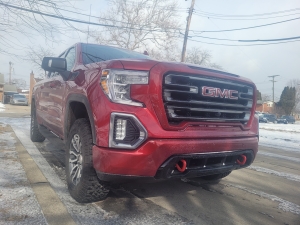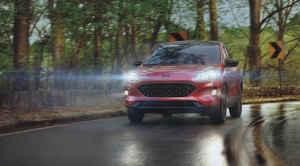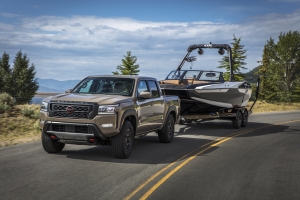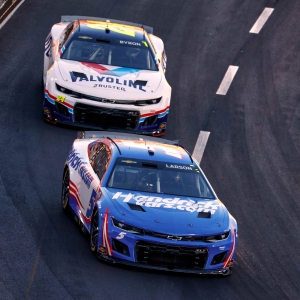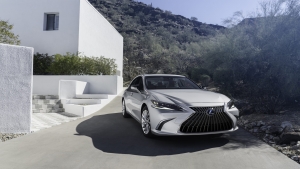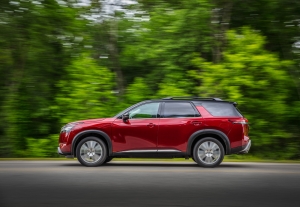
Matt M. Myftiu
Matt Myftiu has been a journalist for two decades with a focus on technology, NASCAR and autos.
GMC Sierra 1500 Limited AT4 is a capable stopgap ahead of full 2022 refresh
As the Scottish poet Robert Burns wrote many moons ago, the best laid schemes of mice and men often go awry. Which is why it’s always good to have a strong backup plan in place.
In the case of the GMC Sierra 1500 pickup truck, a fully refreshed model had been teased for release early in 2022 — featuring exterior and interior styling upgrades, updated infotainment system, among other changes.
But due to production delays caused by ongoing supply chain issues, the arrival of these new Sierras has been delayed until later in 2022. So Plan B — continuing to offer a GMC Sierra 1500 Limited model carried over from the 2021 version — has become the reality for the short-term.
I recently drove the 2022 GMC Sierra 1500 Limited, specifically one equipped with the AT4 off-road package, and I’m back with a full report on what it offers to buyers who aren’t willing to wait for the new version of the Sierra.
Mativ Smart Exercise Mat Launches in United States, Features Connected Workouts
Omolle, a global manufacturer and distributer of connected fitness products based in Seoul, South Korea, is launching a limited release of its new product, Mativ, an interactive AI workout mat.
The Mativ smart mat is paired with a wrist band and embedded sensors that can be used for a variety of activities including High-Intensity Interval Training (HIIT), Pilates, strength training and yoga. The mat’s technology includes video content of instructor-led workouts; real-time feedback such as calorie burn, voice motivation, suggestions and ranking; and provides a virtual community for users to connect with other users, influencers and instructors.
Connected fitness is the most rapidly growing segment of the fitness industry with a predicted average annual growth of 31.2 percent, reaching nearly $6 billion by 2025. Omolle’s vision is to disrupt the connected fitness industry by providing affordable, accessible and intuitively connected fitness equipment to a large audience.
“How people exercise has been forever changed in the past few years and has been accelerated by the coronavirus pandemic,” said Omolle CEO Minki Kang, about the fitness trend toward connected, remote training. “I saw a clear gap in the marketplace in the area of affordable, connected fitness equipment, and our Mativ smart mat is an example of how people can continue to stay in shape on their own terms without spending thousands of dollars to do so.”
The Mativ mat costs $299, and the monthly subscription is $9.99 for content/connectivity. For more information on Mativ, or to pre-order, visit www.mativfitness.com.
Omolle, established in 2018, started to develop fitness content services as a member of Born2Global Center, a South Korean-based government agency that supports startups. The Seoul-based company quickly realized there was an underserved fitness market segment and set out to fulfill it. Omolle’s technological expertise is recognized worldwide, and the company has applied for 50 different patents, trademarks, and designs, both in Korea and abroad. Thirteen patents and other intellectual property rights have already been registered. Omolle was also selected for the Amazon Launchpad program.
ARaymond making an impact on employment for women in engineering, STEM Careers
In view of the increasing shortage of skilled workers, women are an important target group when recruiting for many manufacturing and engineering companies. We spoke to Franziska Gempp (32), HR Manager, at the international automotive supplier ARaymond in Lörrach, Germany, and the trained technical draftswoman Yvonne Maschat (34) about how the specialist for fastening and assembly solutions is doing at its German locations Lörrach and Weil am Rhein, what support the company needs from politicians, what perspectives women have, and what makes a technical profession so exciting.
Ms. Gempp, how are you affected by the shortage of skilled workers and what kind of support would you like from education policy?
Franziska Gempp: The shortage of skilled workers is of particular concern to us in the area of technical jobs. In many cases, we lack skilled workers here – such as a good electrician or a toolmaker. Against this background, the increasing academization worries us. For us, a good education is just as important as a good degree. We are currently noticing that a large number of young people immediately think in the direction of studying and that training is becoming less important. I wish that we would emphasize the value of our very good dual training system in Germany much more. One of our trainees told me that the career orientation at her high school was exclusively geared towards studying. I think schoolchildren should be aware that they can start an apprenticeship with a high school diploma and, based on that, develop further professionally. And they should be able to test whether they are more the type for scientific or practical work. For me, that would be important content that should be discussed in the career orientation phase.
What contribution does your company itself make to career orientation?
For example, we offer many internships, of course also for girls and young women. In view of the shortage of skilled workers, women are an important target group for us, as are career changers or somewhat older applicants. When it comes to women, I think the most important thing is to get them excited about technology at an early age. That's why we target girls at school and bring them into the company through campaigns such as Girls' Day or internships. We often get feedback like "Wow, I hadn't imagined it that way, that's really interesting." Or "I thought that was much more difficult." In addition to the exciting technique itself, this certainly has something to do with the fact that production conditions have changed significantly in recent years and the technical production jobs are no longer associated with heavy physical work. We have lifting aids, etc., so the jobs are suitable for everyone — men and women, but also older workers.
When the women are with you: How does, for example, a technical production job go together with the topic of children or caring for relatives — both topics in which women in particular continue to withdraw from their jobs?
We see to it that we get the best possible outcome for our employees and for us as an employer with flexible working time models – in other words, in production, for example, we talk about shift models that are suitable for childcare. In areas such as construction and development, mobile working is also possible for better compatibility. And then of course we have many part-time models, which are normal for us wherever they are feasible. We keep in touch during parental leave: Many employees come by regularly or, of course, are part of the team at events such as a Christmas party or a barbecue.
Ms. Maschat, as a trained technical draftswoman, you now work as a project manager assistant in the development of ARaymond. How did you get into this technical job?
Yvonne Maschat: I did my training as a technical draftswoman here at ARaymond (today that corresponds to the job profile of a technical product designer) and, with the support of the company, I went to evening classes to do further training to become a technical business administrator. As a result, I got my current job as a project manager assistant in construction. As a technical draftswoman, I was entrusted with developing fasteners for the automotive industry and deriving the drawings from them. As an assistant, I still design today, but I also do a lot of customer communication and know what customers want.
— Content provided by ARaymond
Ford Escape plug-in hybrid is a quality green SUV option
Among automakers, it’s a bit of a race right now to see who can be the one to adapt to the electric vehicle future better than the rest.
Ford is starting to step up in this fight, as it recently announced that it will invest $22 billion in electric vehicles (and $7 billion in autonomous vehicles) through 2025. And it’s already selling new EV offerings such as the Mustang Mach-E and F-150 Lightning.
One step short of a full EV is a plug-in hybrid (or PHEV), and I recently had the chance to test a Ford offering in this realm: The Ford Escape PHEV. This type of vehicle is a good step for people who aren’t quite ready to rely on a fully electric vehicle, but want something other than a traditional ICE ride — either for environmental reasons, or just to get a break from the yo-yo gas prices we so often see.
I tested a 2021 Escape PHEV, but it carries over to the 2022 model year pretty much as-is, other than some new paint options.
StradVision Acquires ISO 26262 Certification, hires Sunghyun Chang as new CFO
STERLING HEIGHTS, MICHIGAN ― StradVision, an AI-based vision processing technology company for Autonomous Vehicles and ADAS, announced that it has obtained the ISO 26262 certification for automotive functional safety from TÜV Rheinland, a globally renowned third-party testing, inspection and certification company.
The ISO 26262 certification was established as a global standard by the International Organization for Standardization (ISO) in 2011 to minimize risks from electric or electronic system malfunction in vehicles. StradVision, which recently unveiled its new North American headquarters in Sterling Heights, has been recognized as a software supplier with a high level of functional safety, satisfying automotive customers' demands by meeting the requirements of ISO 26262 throughout the development and management process of its camera perception software SVNet.
“The automotive industry is transforming into a new business that provides new mobility, transportation, and various experiences in the car as a service, and software is the most powerful driver of this change,” StradVision CEO Junhwan Kim said. “The acquisition of ISO 26262 Functional Safety Management certification demonstrates StradVision's competence as a global leader in software, a key component of future mobility innovation.”
Currently, the automotive industry is focused on adopting various driver assistance features in vehicles to improve safety and convenience for drivers and pedestrians. As the performance of semiconductors and adoption of diverse sensors in vehicles continues to increase, the importance of safety standards for software, and their level of sophistication, has also risen.
“StradVision has successfully built its management system that delivers camera perception software meeting the functional safety requirements for automakers and automotive tier-1 suppliers,” said Frank Juettner, CEO of TÜV Rheinland Korea. "We are pleased to present ISO 26262 certification for the software that will contribute to enhancing functional safety in the automotive industry.”
StradVision, established in 2014 in South Korea, continues to accelerate the advancement of Autonomous Vehicles. SVNet, its AI-based vision perception software, achieves higher efficiency in memory usage and energy consumption and can be customized and optimized to any system on a chip (SoC).
The software that has been honored with the Gold Award at the 2021 AutoSens Awards for Best-in-Class Software for Perception Systems is currently used in mass production models of ADAS and autonomous driving vehicles that support safety function Levels 2 to 4, and will be deployed in more than 50 vehicle models from 13 OEMs worldwide.
StradVision Appoints Sunghyun Chang as Chief Financial Officer
StradVision has also announced the appointment of Sunghyun Chang as Chief Financial Officer (CFO). In this position, Chang will lead StradVision’s financial team and is responsible for corporate financial actions and strategic growth initiatives, as well as investor relations.
StradVision expects to further strengthen its overseas business capabilities by recruiting Chang, who has accumulated experience in international financial management throughout his career.
“This year, we plan to expand our business in key markets where major automakers are located, including North America, and for this, we want to strengthen investment and recruitment in overseas subsidiaries,” StradVision CEO Junhwan Kim said. “We anticipate that the appointment of Sunghyun Chang, Chief Financial Officer, who has experience in financial management in various industries, will give us greater strength to achieve this strategic goal.”
Chang is a finance expert who started his career at KPMG, one of the four largest accounting firms in Korea. During his tenure at KPMG, Chang served as an overseas dispatcher in Europe for three years. Since then, he has worked for various companies and industries such as Anheuser-Busch InBev, the world's largest brewer; Gencurix, a molecular diagnostic solutions company, and B2Link, a K-beauty commerce company.
Chang holds a U.S. Charted Financial Analyst (CFA) certificate in addition to his Certified Public Accountant (CPA) qualification, and has been mainly in charge of financial management of multinational corporations, attracting foreign investment for startups, and managing investor relations.
2022 Nissan Frontier delivers with long-awaited refresh
Some vehicles offer updated models every few years, others not so much. You can definitely put the Nissan Frontier in the second category.
Believe it or not, the last major redesign of the Frontier — Nissan’s mid-size pickup truck — came way back in 2005, an eternity in today’s automotive world.
Naturally, recent-year models were lacking compared to newer offerings from the competition, but finally in 2022 Nissan has decided to put that to an end.
The 2022 Nissan Frontier — which I recently was able to test — improves on the design of the vehicle, brings updates under the hood, and boosts the tech and safety offerings.
Read on to learn more about how the brand new Frontier compares to other leading trucks in this segment.
NASCAR hits home run with Clash at the Coliseum: 5 Top Takeaways
NASCAR’s bet on a spectacle in L.A. paid off
Many doubted NASCAR when this unprecedented event was announced. But between the amazing and historic venue that looked beautiful on TV (and no doubt in person, too), tremendous on-track action and musical entertainment from Pitbull and Ice Cube, and an impressive crowd, the Clash at the Coliseum is something that exceeded NASCAR’s wildest expectations.
Joey Logano put on a tough battle with Kyle Busch up front to take the inaugural win for the Next Gen car, and in the process NASCAR exposed itself to a California audience largely composed of people who don’t normally follow the sport. Here’s hoping they stick around and remain fans of the sport as we head into the Daytona 500 and beyond.
I can see the Clash coming back to the Coliseum next year, but we need to be careful to make these things special, and not try to do them multiple times a year. Make it a destination every February; and later, once it’s served its purpose, give another stadium a chance.
One thing is certain. The Clash, which had become an almost forgotten and frankly boring event at Daytona, has been revitalized, and we’re not going to back to the old ways again. Kudos to Ben Kennedy, the future of the sport’s leadership, for pushing the sport in bold, new directions despite some howling from legacy fans.
2022 Kia Carnival: 5 Things to Know
There’s been a ton of buzz about the Kia Carnival since it hit the market, with many — including myself — considering it the best minivan available, surpassing such heavyweights as the Honda Odyssey, Toyota Sienna and Chrysler Pacifica.
But what’s all the fuss about?
I’ll break it down with 5 key facts you need to know about this headline-stealing new vehicle, which is a major upgrade from the previous Sedona minivan offered by Kia.
2022 Lexus ES 300h is a sharp-looking, smooth-riding, roomy luxury hybrid
WIth so many automakers making commitments to going fully electric in the years to come, one question is what will happen to hybrids once all the dust settles. WIll they still have a place in the automotive landscape?
I believe they will, though it will be a more limited role and only the best ones will survive and thrive. Not everyone will want to go electric in the short-term, so having quality hybrid options is a nice middle ground for this group.
On the luxury end of the world of sedans, one gem that is likely to continue shining is the Lexus ES 300h, a sedan that is a rare combination of roominess, strong fuel economy and an enjoyable ride. It has few true competitors as a midsize hybrid sedan, and is priced well in comparison to the few hybrids it does battle (Audi A6, Benz E-Class).
Changes for 2022 include the addition of the F Sport trim level to the hybrid ES, improved safety features, updates to the tech setup, and slight design changs.
I recently spent a week in the ES hybrid, an F Sport version to be exact, and I’m back with a full report.
Redesigned 2022 Nissan Pathfinder delivers strong tech upgrades, bolder look
I’ve long been a fan of the Nissan Pathfinder, a three-row SUV that has been around for nearly four decades and has often been ahead of the curve in terms of capability, design and technology. I have driven them on long road trips in the past and found them to be very comfortable and among the strongest 3-row SUVs for families traveling near or far.
But with its latest major updates coming in 2016, it was about time for a redesign. With an endless assault from rival SUVs unveiling their latest and greatest, you can’t stay stagnant that long in this business. So the 2022 model year brings us a brand new Pathfinder model — completely redesigned inside and out — that is more in tune with the current state of SUVs.
I recently spent some time behind the wheel of this new Pathfinder, and I’m back with a full report. WIll this new version live up to its past, and does it measure up to the seemingly endless competition in the segment?
News Categories
Popular Tags
Search Reviews by Make

AutoTechReviews is your home for In-depth reviews of the latest cars, trucks, and SUVs; information on all the emerging vehicle technology; and breaking news from the world of NASCAR and other motorsports.
